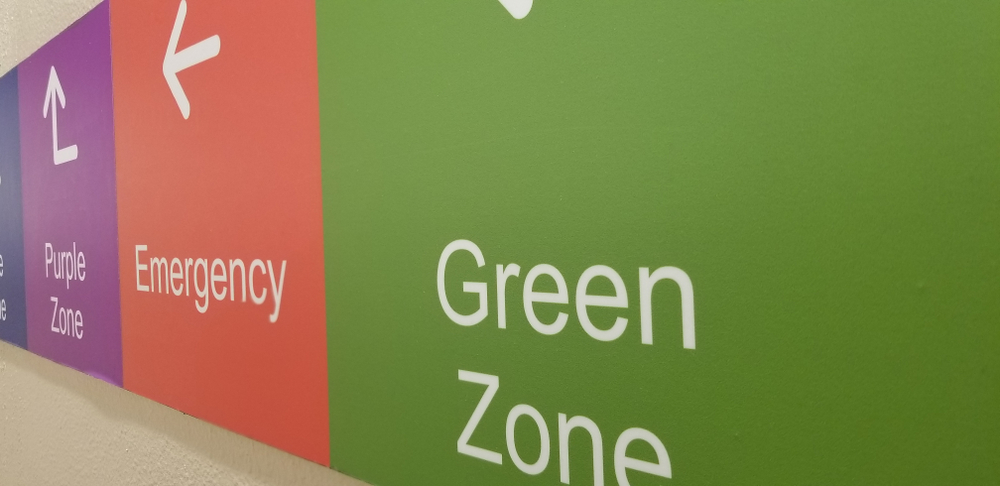Medicine is among the most challenging professions. On top of all the years of intense study, self-discipline, and hard work, hospitals are complicated by the fact that not all patients are cooperative and peaceful.
Healthcare workers often face surly, angry, or even aggressive patients and other hospital visitors, even in emergency rooms.
In a hospital, “code gray” is used when an aggressive or violent patient is causing hospital staff a problem. There is a well-trained emergency response team that hospital staff can call upon to deal with these incidents, designated “the code gray team.”
Code Gray team members are trained to protect and preserve everyone’s safety at the hospital.
Table of Contents
Hospital emergency codes
Codes used in hospitals for emergency situations are codified messages. Typically, these messages get broadcasted on the public address system to inform staff of various types of emergency situations.

The codes are designed to communicate important information quickly without confusing staff members. At the same time, using the codes is meant to avoid causing patients or hospital visitors anxiety or stress.
Staff badges and hospital signs often show these codes as quick reminders for employees.
Hospital emergency codes vary significantly by location and even within hospitals in similar communities. For example, in several American, Canadian, New Zealand, and Australian hospitals, “code blue” signals a cardiac arrest, whereas “code red” signals a fire inside the hospital.
The uncertainty and irregularity of these codes resulted in a push for the standardization of codes.
American hospital codes
Everybody and his brother had their own code
In the early 2000s, HASC (the Hospital Association of Southern California) realized hospitals urgently required standardized codes when three people died in a shooting at a hospital because of an incorrect emergency code.
A HASC survey found that although the majority of California hospitals used “code red” for fire and “code blue” for medical emergencies, nearly 50 different codes were used for child kidnapping, and over 60 codes signaled that someone was being dangerously aggressive.
The outcome of the shooting and the subsequent survey resulted in an update to the HASC handbook that listed numerous codes and insistence that hospitals adopt the new codes.
National hospital system codes

Code Gray: Someone is being combative or violent. Code Silver is more appropriate where a weapon is involved.
Amber Alert/Code Adam: The abduction of a child.
Code Blue: Heart or breathing stopped.
Code Brown: Extreme weather; can also mean–yuck–the uncontrolled discharge of feces. When such a discharge happens, nurses or other personnel must deal with the mess.
Code Clear: This indicates that any previous emergency is over, and the hospital has returned to its normal routine.
Code Orange: Spillage, or accidental exposure to spillage, of hazardous material.
Code Pink: The abduction of a baby (compare to Code Adam or Amber Alert) or an obstetrical emergency.
Code Red: Fire or smoke in the building.
Code Silver: This is issued when someone being violent or aggressive has either a weapon or is holding a hostage (see Code Gray above).

Code White: A neonatal emergency. (Some hospitals use Code Violet instead, so this code has yet to be completely standardized.)
Code Green: Activates (specified) emergency procedures.
Code Black: This is issued when there is a credible bomb threat.
As part of the standardization of hospital codes, authorities decided that every code must be coupled with a specific location. For example, a simple “code red” wouldn’t suffice.
To be correctly formed, the announcer would have to say something like “Code red, third floor, corridor two, room 312.” This requirement does not apply to those codes that only inform hospital staff to prepare for the potential consequences of an external event like a natural disaster.
The beginning of the end for hospital color codes?

As recently as 2015, the Hospital Association of South Carolina established a working group to create standards for non-color codes that used plain language instead. The ultimate aim was, therefore, the total elimination of all color codes.
The British got a jump start on non-color hospital codes
Non-color codes are already used throughout the NHS (National Health Service), Britain’s outstanding “free at the point of delivery” health service.
2222: Dialing 2222 on an internal telephone in NHS hospitals instantly connects to the switchboard. Upon identifying the nature of the emergency, the switchboard operator will contact the relevant personnel.
3333: Security alert.
4444: Fire alert.
Code Gray situations and how to handle them
Knowing how to stay calm when confronted by an aggressive patient and remaining in a safe environment are vital techniques for all healthcare workers, especially those engaged in locum support.

Doctors and nurses can find themselves in situations that quickly escalate from rudeness to shouting to being grabbed and manhandled or assaulted with fists and even with weapons.
In one example reported in medical literature, a thirty-year-old man complained of an irritable throat and symptoms reminiscent of a cold. The patient had a recorded history of violent behavior, but the locum doctor had been unable to go through the patient’s notes before calling the patient.
The patient’s aggressive response followed the classic cycle of escalation and resulted in the doctor being thrown to the ground by the patient.
As an indicator of the frequency of such attacks, in a one-year span between 2008 and 2009, England’s NHS staff endured a total of 3,472 similar episodes.
Why do patients become aggressive?
Patients typically have high expectations of their doctor’s ability to care for them. When they are not satisfied or delayed, they are angry, worried about their health, and often aggressive or threatening.
In many cases, aggression can disguise ineffective communication or interpersonal abilities.
Attacks on healthcare workers can result from delays or errors of treatment to the absence of privacy and other environmental issues, like noise, heating, or air conditioning. The angry patient might have personal problems or have an addiction to alcohol or drugs.
Being prepared for aggression or violence is half the battle won
Violence can be random and without warning, but in best-case scenarios, processes that ensure the availability and use of pre-planned warnings ought to be in place. Healthcare workers themselves must be on the lookout for signs of agitation or rage in patients.
Body language showing clenched fists, finger-pointing, or abrupt movements can signal a brewing storm.
Some practices use the “front-desk system” where recorded warnings show beside the names of troublesome patients. For example, “Patient verbally aggressive towards receptionist” is a common warning.
The NHS protocol is for hospitals to share these alerts with the patient involved, a practice that has been found to positively affect a few of these patients.
Some patients will get angry no matter what hospital staff do. However, with suitable safety measures in place, each patient can be treated with respect, and situations, where heated discussions are likely to turn into aggressive behavior, can be quickly identified and dealt with early.
How some hospitals try to avoid Code Gray situations by being proactive with violent patients

Staff members are taught self-defense and counseling. Additionally, everyone is trained to know where to be when a violent patient is on the premises.
Violent patients admitted to the hospital are treated respectfully, but responsibly, in such a way as to protect staff and other patients. Such treatment may include the use of restraints.
Also, as much as possible, the same familiar doctors will often treat violent patients to lessen the probability of a blowup.
Locums and local out-of-hours medical staff are given a current list of violent patients to keep them up-to-date and fully informed. Panic buttons at the hospital are directly linked to the police.
However, the staff is trained and expected to calm a patient before involving the police, as this may fuel and increase the tension among violent patients.
“Doctor Brown” is another “code gray”
It is easy to find several “Doctor Brown” profiles on the Internet claiming to offer sterling medical services. However, in a hospital, “Doctor Brown” on the public address system is actually an urgent alert.
This is because “Doctor Brown” is the secret emergency code, and it is used to notify security personnel of the presence of a potentially dangerous person in the hospital.
If a patient becomes violent, medical staff, doctors, nurses, and attendants can issue an alert using the code “Doctor Brown.” In this way, “calling Doctor Brown” is exactly the same as giving a “code gray.”
The only difference between this and the color system is that the color-coded system can distinguish between an armed and unarmed aggressive person. (A “code silver” is used to alert security of an armed aggressive person, not “code gray.”)
Code Gray standards
Code Gray Standards set out the essential requirements for a coordinated response by the organization to manage and prevent occupational aggression and violence. The standards are intended to:
- Reduce the chance of injury for personnel, patients, and visitors
- Ensure patients get treated respectfully and in a safe manner, and that their needs are met
- Make sure health care providers have a consistent escalation procedure for any threat, which allows staff to respond consistently.
How hospital staff use code gray standards
Code Gray Standards prescribe a step-by-step method of designing and implementing a uniform approach. When it comes to establishing the fundamentals of the Code Gray response or making improvements to processes already integrated into daily practice, the use of the code must be designed to offer health care services, including at a minimum:
- the personnel and resources needed to prepare the organization to be effective in Code Gray responses
- a program for monitoring the efficiency of Code Gray responses through evaluation of the results and arrangements for operational governance.
What is the typical composition of a Code Gray team?

The Code Gray team comprises designated personnel who have been specifically trained and are readily available to assist with Code Gray incidents at their healthcare facility. Furthermore:
- The Code Gray team must include security-trained and clinically trained personnel.
- Members of the Code Gray team must comply with all relevant hospital policies and procedures. They must conform to applicable state-wide guidelines, including those relating to the application of seclusion, restraint, and/or weapons search and management.
- Code Gray and Code Black teams must consist of the same responders in health services or particular units or sites within a specific health service that does not operate guidelines regarding usage of restraint, weapons searches, or weapons management. This is in case escalation of a Code Gray to a Code Black occurs.
- The composition, the scope of practice, and training for Code Gray (and Black) teams should be planned with clear documentation for every section of the organization and in the health emergency procedures manuals. In all instances, it must be obvious who constitutes those who make up the Code Gray and Code Black response on the ground for the organization.
How healthcare workers can help prevent Code Gray situations
Code Gray is utilized in cases of violence or aggression in the hospital. The Code Gray support team is trained to intervene and disarm the aggressor, calm the situation, and protect everyone present.
Code Gray is related to Code Silver, the only difference being that the aggressor is unarmed in a Code Gray situation and armed in a Code Silver one.

















